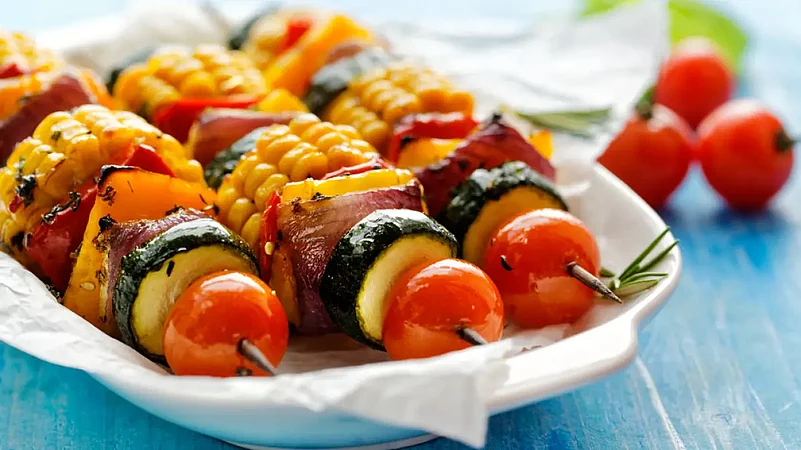Vibrance and Warmth in Chettinad

The UNESCO-accredited site of Chettinad in Tamil Nadu has its own cuisine. Originally, the Chettiars, who settled there around 3,000 years ago, were a group of traders of salts and spices who were known to be extremely rich and used to host lavish feasts. The present-day rendition of their cuisine features some of the best fish gravies and prawn curries you can taste in the world. Their well-crafted menu also includes items such as brain masala, stomach sambols and pepper chicken along with an exquisite vegetarian banquet replete with miniature potato fries, appams, idlis, idiyappam, adais, dosais and dried curries. A trip to the cluster of 76 Chettinad villages could be worth your while, if only for tasting the sheer complexity and rich flavours of spices and condiments mixed in one dish.
> In the Sangam era, huge establishments were created above sea level to save the spices from continuous droughts and floods
Veganism Amidst the Odds

Finding vegan food while pedalling across borders can be hard, but not impossible. While traversing across the country and choosing a vegan lifestyle, get your hands on masala dosas, idlis, dal makhani, kofta, rajma, and chole kulche. Being a land full of varied cultures and food preferences, India is also famous for culinary tourism, and it is fairly easy to find vegan and vegetarian food items. Despite all of its seafood attractions, PETA (People for the Ethical Treatment of Animals) has also accredited Goa to be India's most vegan-friendly state with popular vegan and vegetarian restaurants like Zest, Blue Planet Cafe, Bean Me Up, Soul Booster Bar, Cafe Tato, Chia Lounge, among others, that offer a plethora of vegan delicacies. The Silicon Valley of India, Bengaluru, too has an array of vegan-friendly and vegetarian restaurants such as Santé Spa Cuisine, Green Theory, The London Curry House, and others. Gujarat, Haryana, Rajasthan and Punjab are also increasingly offering multiple vegan options.
> It takes more than 2,400 gallons of water to produce one pound of beef, but only 25 gallons to produce a pound of wheat
Beyond Momos and Noodles in Ladakh

If you thought momos, thukpa and noodles were all there is to Ladakhi cuisine, think again. There are many sumptuous dishes awaiting your approval, but you could start with the delightfully aromatic and homely Ladakhi pulao, prepared with white rice, mutton stock and caramelised onions, carrots and nuts. You may not find it at the street vendors’, but it is a mainstay in many Ladakhi households. Next up is the skyu soup, a comfort dish in which small, thumb-sized balls of barley or wheat dough are boiled and cooked slowly along with root vegetables like potatoes, carrots and turnips. For a different taste altogether, give chhurpi a shot. It is a variety of cheese that is made from yak milk and comes in three versions: plain, sweet and salty. Chhurpi is commonly cherished with an interesting range of bread and stews such as the sweet and tangy tingmo, the extremely thick khambir or even homemade pasta. For your day’s source of protein, don’t miss dastuk, a homespun porridge of rice, yak milk and butter, salt, pepper, wild greens and capers that is often considered to be the best meal on chilly winter days.
> Order butter tea with khambir, and have a traditional ladakhi tea time to keep your body warm
Sour and Spice on a Parsi Food Trail

If the Parsis had not arrived on Indian soil and imbibed it with their wonderful culture, India, as a whole, would not have been the same. While their contributions to the economic world are notable, their distinct gastronomy is as significant. In the states of Gujarat and Mumbai, especially, its influence has been paramount. Parsi cuisine is a mix of delicacies as diverse as the civilisation itself. After moving from Persia, the group lived on the Gujarat coast. This unique background gives Parsi food a distinctive taste due to the amalgamation of gosht (meat), dry fruits from its Irani roots, nuts, eggs, and potatoes — all seasoned with a variety of spices. One of the most popular traditional Parsi dishes is jardaloo salli boti. Using boneless cubes of meat called boti, this tangy and spicy Parsi meat is served with store-bought matchstick potatoes called salli. Then there is sali per eedu, which is the Parsi-Indian version of shakshuka, with a lot of flavours and poached eggs. Mumbai is also quite famed for its Parsi cafes and restaurants such as Britannia and Co., Cafe Military, and more.
> Parsis first migrated to India from Iran in the 7th-8th century CE to preserve their culture and heritage
















